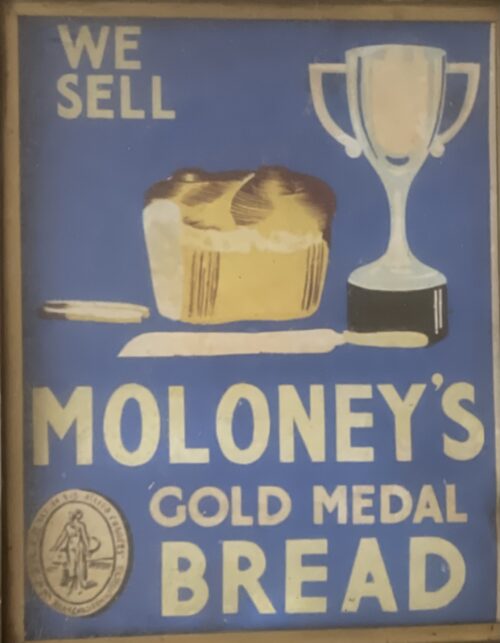-

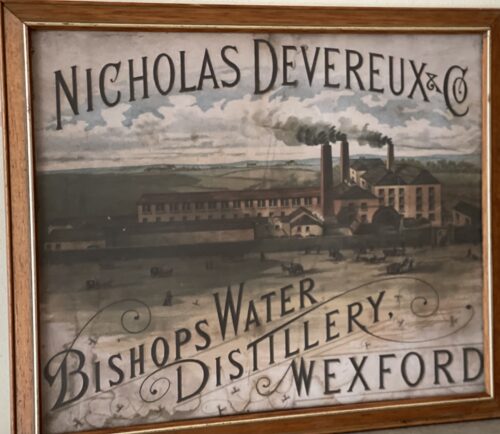 40cm x 34cm LimerickBishops Water Distillery(subsequently known as Nicholas Devereux Finest Irish Whisky) was an Irish whiskey distillery which operated in Wexford, Ireland between 1827 and 1914. The distillery was named for a stream which ran along the back of the distillery, the Bishop's Water, said to possess "various occult properties derived from the blessings of the sainted Bishop of Ferns". Constructed at a cost of £30,000, the distillery was reported to be “reckoned the most perfect and complete of the kind in Ireland”.In 1833, just a few years after it opened, the distillery recorded an output of about 200,000 gallons per annum .However, output had fallen to just 110,000 gallons per annum in 1886, when the distillery was visited by Alfred Barnard, as recorded in his seminal 1887 publication "The Whisky Distilleries of the United Kingdom". This was amongst the lowest output of any distillery operating in Ireland at the time, and far below the potential output of 250,000 gallons per annum reported when the distillery was offered for sale as a going concern in 1909. The distillery's whiskey, Barnard noted, was highly appreciated locally, and in the British cities where it was exported. In the early 20th century, with the Irish whiskey industry in decline, Bishop's Water distillery, like the majority of distilleries in Ireland at the time, suffered serious financial difficulties, and entered bankruptcy. Following its closure, the distillery was initially converted into an iron works (Pierce Ironworks). However, much of the site was later demolished, and little evidence of the distillery still remains. Some mementos can still be found in locals pubs, while a stone archway known to have been extant in 1903 and now bearing the inscription "Casa Rio", possibly in reference to the location of a Pierce ironworks office in Buenos Aires, marks the entrance to the site where the distillery once stood, on Distillery Road. In 1827, a whiskey distillery was established on what is now Distillery Road, Wexford by a consortium of businessmen. The consortium which traded under "Devereux, Harvey, and Co., Distillers", comprised a number of local businessmen, including Nicholas Devereux, his father John Devereux, and Maurice Crosbie Harvey. John Devereux had previously operated a small distillery in the area in the late 1700s, but will little success. In 1830, one of the partners, Maurice Harvey, was accidentally killed at the distillery by an excise man who was taking aim at some birds flying overhead. A few years later, in 1836, the partnership was dissolved at the mutual consent of the remaining partners, with Nicholas Devereux taking sole ownership of the distillery, after which the distillery traded under the name Nicholas Devereux & Son.On his death in 1840, operation of the distillery was taken over by his son Richard. Nichloas Devereux's granddaughter, Mary Anne Therese was also deeply involving in the distilling industry. She married John Locke, founder of the larger Kilbeggan distillery, and successfully took over the business operations of the distillery on his death in 1868. According to Alfred Barnard, the British journalist who visited Bishop's Water in the 1880s, the distillery produced triple-distilled "old pot still whiskey", which was sold locally in Ireland, and also exported to London, Liverpool, and Bristol. At the time of his visit, the Malt Warehouses on-site contained over 16,000 barrels of pure malt. In addition, upwards of 3,000 casks of whiskey were undergoing maturation at the distillery. Whiskey from the distillery is also noted to have been used in the production of blended whiskeys in later years. In the early 20th century, the distillery suffered financial difficulties. In 1907, an attempt was made to appoint a receiver, and in 1909, the distillery was put up for sale, but no takers could be found.In 1914, distilling eventually ceased at the site, and the remaining stocks were sold off.
40cm x 34cm LimerickBishops Water Distillery(subsequently known as Nicholas Devereux Finest Irish Whisky) was an Irish whiskey distillery which operated in Wexford, Ireland between 1827 and 1914. The distillery was named for a stream which ran along the back of the distillery, the Bishop's Water, said to possess "various occult properties derived from the blessings of the sainted Bishop of Ferns". Constructed at a cost of £30,000, the distillery was reported to be “reckoned the most perfect and complete of the kind in Ireland”.In 1833, just a few years after it opened, the distillery recorded an output of about 200,000 gallons per annum .However, output had fallen to just 110,000 gallons per annum in 1886, when the distillery was visited by Alfred Barnard, as recorded in his seminal 1887 publication "The Whisky Distilleries of the United Kingdom". This was amongst the lowest output of any distillery operating in Ireland at the time, and far below the potential output of 250,000 gallons per annum reported when the distillery was offered for sale as a going concern in 1909. The distillery's whiskey, Barnard noted, was highly appreciated locally, and in the British cities where it was exported. In the early 20th century, with the Irish whiskey industry in decline, Bishop's Water distillery, like the majority of distilleries in Ireland at the time, suffered serious financial difficulties, and entered bankruptcy. Following its closure, the distillery was initially converted into an iron works (Pierce Ironworks). However, much of the site was later demolished, and little evidence of the distillery still remains. Some mementos can still be found in locals pubs, while a stone archway known to have been extant in 1903 and now bearing the inscription "Casa Rio", possibly in reference to the location of a Pierce ironworks office in Buenos Aires, marks the entrance to the site where the distillery once stood, on Distillery Road. In 1827, a whiskey distillery was established on what is now Distillery Road, Wexford by a consortium of businessmen. The consortium which traded under "Devereux, Harvey, and Co., Distillers", comprised a number of local businessmen, including Nicholas Devereux, his father John Devereux, and Maurice Crosbie Harvey. John Devereux had previously operated a small distillery in the area in the late 1700s, but will little success. In 1830, one of the partners, Maurice Harvey, was accidentally killed at the distillery by an excise man who was taking aim at some birds flying overhead. A few years later, in 1836, the partnership was dissolved at the mutual consent of the remaining partners, with Nicholas Devereux taking sole ownership of the distillery, after which the distillery traded under the name Nicholas Devereux & Son.On his death in 1840, operation of the distillery was taken over by his son Richard. Nichloas Devereux's granddaughter, Mary Anne Therese was also deeply involving in the distilling industry. She married John Locke, founder of the larger Kilbeggan distillery, and successfully took over the business operations of the distillery on his death in 1868. According to Alfred Barnard, the British journalist who visited Bishop's Water in the 1880s, the distillery produced triple-distilled "old pot still whiskey", which was sold locally in Ireland, and also exported to London, Liverpool, and Bristol. At the time of his visit, the Malt Warehouses on-site contained over 16,000 barrels of pure malt. In addition, upwards of 3,000 casks of whiskey were undergoing maturation at the distillery. Whiskey from the distillery is also noted to have been used in the production of blended whiskeys in later years. In the early 20th century, the distillery suffered financial difficulties. In 1907, an attempt was made to appoint a receiver, and in 1909, the distillery was put up for sale, but no takers could be found.In 1914, distilling eventually ceased at the site, and the remaining stocks were sold off. -

 Beautifully atmospheric lithograph of the pre match parade by the Cork and Dublin Hurlers in 1952.This lithograph was sponsored by the National Flour Mills Co.Ltd. 42cm x 46cm Douglas Cork
Beautifully atmospheric lithograph of the pre match parade by the Cork and Dublin Hurlers in 1952.This lithograph was sponsored by the National Flour Mills Co.Ltd. 42cm x 46cm Douglas Cork
The 1952 All-Ireland Senior Hurling Championship Final was the 65th All-Ireland Final and the culmination of the 1952 All-Ireland Senior Hurling Championship, an inter-county hurling tournament for the top teams in Ireland. The match was held at Croke Park, Dublin, on 7 September 1952, between Cork and Dublin. The Leinster champions lost to their Munster opponents on a score line of 2-14 to 0-7.1952 All-Ireland Senior Hurling Final 
Event 1952 All-Ireland Senior Hurling Championship Cork Dublin 2-14 0-7 Date 7 September 1952 Venue Croke Park, Dublin Referee W. O'Donoghue (Limerick) Attendance 71,195 Origins : Co CorkDimensions : 31cm x 36cm 1.5kg -

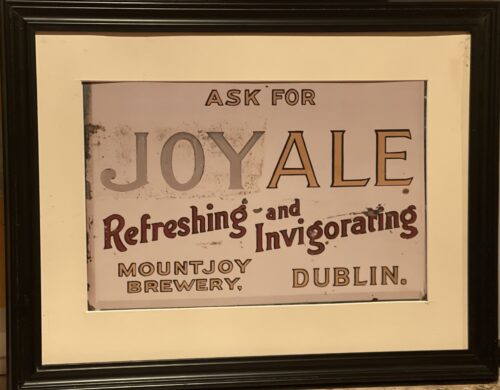 44cm x 52cmMountjoy Brewery Ltd, Russell Street, Dublin, Ireland. Founded 1852. Known as Findlater & Co. until June 1891. Closed 1957. From the Brewery History society Journal Number 91 Founded by Alexander Findlater, a Scottish businessman, in 1852. Primarily a porter brewer but later ale brewers. They enjoyed local, military and export trade with markets in the UK and the colonies. The brewery passed into the hands of Messrs Malone & Blood in 1900 and had by this time become the largest exporter of porter next to Guinness through the port of Dublin. It outlived all its rivals in Dublin apart from Guinness and closed in 1957.
44cm x 52cmMountjoy Brewery Ltd, Russell Street, Dublin, Ireland. Founded 1852. Known as Findlater & Co. until June 1891. Closed 1957. From the Brewery History society Journal Number 91 Founded by Alexander Findlater, a Scottish businessman, in 1852. Primarily a porter brewer but later ale brewers. They enjoyed local, military and export trade with markets in the UK and the colonies. The brewery passed into the hands of Messrs Malone & Blood in 1900 and had by this time become the largest exporter of porter next to Guinness through the port of Dublin. It outlived all its rivals in Dublin apart from Guinness and closed in 1957.Entry in the Trade Mark Registry Registration No : 5,664 Description : Three castles in shield Date of Application : 13/5/1876 Used Prior to 1875? : 10 years
Registration No : 5,665 Description : Crown in shield Date of Application : 13/5/1876 Used Prior to 1875? : 10 years Registration No : 156,739 Description : Label design Date of Application : 26/5/1891 Used Prior to 1875? : Since Aug 1875 Registration No : 372,597 Description : Joy (word) Date of Application : 19/04/1916 Used Prior to 1875? : NO -

 65cm x 90cm Banagher Co Offaly Rare example of a very old & impressive advertising print ,depicting a well known type of Port of the time and a nice northern Portuguese vista .Adam Millar's were a well known spirits, wine and cordials merchant in the Liberties section of Dublin.The firm also bottled for such behemoths as Jameson's and Roe's as well as producing their own Black label whiskey until the company's sad closure in the mid 20th century.The practice of merchant bottling was commonplace in Ireland and many of the best known Irish whiskies today started out as such.Jamesons in particular did not officially bottle their own whiskey until 1968 and up to this point offered their products only by the barrel.
65cm x 90cm Banagher Co Offaly Rare example of a very old & impressive advertising print ,depicting a well known type of Port of the time and a nice northern Portuguese vista .Adam Millar's were a well known spirits, wine and cordials merchant in the Liberties section of Dublin.The firm also bottled for such behemoths as Jameson's and Roe's as well as producing their own Black label whiskey until the company's sad closure in the mid 20th century.The practice of merchant bottling was commonplace in Ireland and many of the best known Irish whiskies today started out as such.Jamesons in particular did not officially bottle their own whiskey until 1968 and up to this point offered their products only by the barrel. -

 45cm x 34cm The Midland Great Western Railway (MGWR) was the third largest Irish gauge (1,600 mm (5 ft 3 in)) railway company in Ireland. It was incorporated in 1845 and absorbed into the Great Southern Railways in 1924. At its peak the MGWR had a network of 538 miles (866 km), making it Ireland's third largest network after the Great Southern and Western Railway(GS&WR) and the Great Northern Railway of Ireland. The MGWR served part of Leinster, County Cavan in Ulster and much of Connacht. Its network was entirely within what in 1922 became the Irish Free State.
45cm x 34cm The Midland Great Western Railway (MGWR) was the third largest Irish gauge (1,600 mm (5 ft 3 in)) railway company in Ireland. It was incorporated in 1845 and absorbed into the Great Southern Railways in 1924. At its peak the MGWR had a network of 538 miles (866 km), making it Ireland's third largest network after the Great Southern and Western Railway(GS&WR) and the Great Northern Railway of Ireland. The MGWR served part of Leinster, County Cavan in Ulster and much of Connacht. Its network was entirely within what in 1922 became the Irish Free State.Early development
The Midland Great Western Railway Act received the Royal Assent in July 1845, authorising it to raise £1,000,000 capitaland to build a railway from Dublin to Mullingar and Longford and to buy the Royal Canal. Construction of the main line began from Dublin in January 1846 and proceeded westwards in stages, supervised by chief engineer G. W. Hemans. It opened from Dublin Broadstoneas far as Enfield in May 1847,to Hill of Down in December 1847 and to Mullingar in October 1848Dublin to Galway
Rivalry existed between the MGWR and the GS&WR, each of which wanted to build the line to Galway. The MGWR extended its line from Mullingar and the GS&WR from its line at Portarlington. The MGWR was first, going via Athlone and reaching Galway, 126.5 miles (203.6 km) from Dublin, in August 1851.It was not until 1859 that the GS&WR got as far as Athlone. The GS&WR was obliged to operate its service over MGWR track between Athlone and Galway, paying the MGWR 65% of passenger and 55% of goods receipts. The GS&WR retained a separate station, which is now the sole operating station, as the last service to the MGWR station ran on 13 January 1985.. The branch is to be made into a rail trail as part of the Dublin-Galway Greenway by 2020.Galway to Clifden
In 1890 the Government granted the MGWR £264,000 to build a railway to Clifdenon the Atlantic coast of County Galway. It opened as far as Oughterard in January 1895 and to Clifden in July 1895.Due to its inland route it did not serve the bulk of the area's population, so the GSR closed it in 1935. A similar branch line was built at the same time from Westport to Achill on the Atlantic coast of County Mayo. The MGW built the first section, opening it as far as Newport in February 1894 and Mulranny in May 1894.The Board of Works built the section from Mulranny to Achill, which opened in May 1895.The GSR closed the line in 1937.Branch lines
At its peak the MGWR had a number of branch lines: Tunnel at Newport on the Westport to Achill branch line.
Tunnel at Newport on the Westport to Achill branch line.- Clonsilla to Navan (opened as the Dublin and Meath Railway 1862, leased to the MGWR 1869, sold to the MGWR 1888)
- extension from Navan to Kingscourt, (opened by the Navan and Kingscourt Railway 1865, sold to the MGWR 1888)
- Kilmessan Junction to Athboy (opened 1864, closed 1963)
- Nesbitt Junction (near Enfield) to Edenderry (opened 1877, closed 1963)
- Streamstown to Clara, County Offaly (opened 1863, closed 1963)
- Attymon Junction to Loughrea (light railway worked by the MGWR, opened 1890)
- Galway to Clifden (opened 1895, closed 1935)
- Westport to Achill (opened 1895, closed 1937)
- Inny Junction to Cavan Town (opened 1856, closed 1960)
- Kilfree Junction railway station to Ballaghaderreen (opened by the Sligo and Ballaghaderreen Railway 1874, sold to the MGWR 1877, closed 1963)
- Crossdoney to Killeshandra (opened 1886, closed 1960)
- Athlone to Westport (opened by the Great Northern and Western Railway 1860–66, leased to the MGWR 1870, sold to the MGWR 1890)
- Claremorris to Ballinrobe (light railway worked by the MGWR, opened 1892, closed 1960)
- Manulla to Ballina, County Mayo (opened 1873)
- extension from Ballina to Killala (opened 1893, closed 1937)
Consolidation
In 1924 the Oireachtas of the Irish Free State passed the Railways Act, which that November merged the MGWR with the Great Southern and Western Railway(GS&WR), Cork, Bandon and South Coast Railway to form the Great Southern Railway. In January 1925, that was joined by the Dublin and South Eastern Railwayto form the Great Southern Railways.Locomotives and rolling stock
Locomotives and rolling stock were maintained at MGWR's Broadstone works in Dublin.Livery
The MGWR painted all of its locomotives bright emeralduntil about 1902, when the first of the new Class A 4-4-0 express locomotives were outshopped in royal blue.This did not wear well and in 1905 the company adopted grass green. From about 1913 locos were painted gloss blackuntil the MGWR became part of the GSR in 1925. From then on, all locomotives were gradually repainted plain unlined dark grey. Passenger coaches were finished in varnish or brown paint until the blue livery was introduced in 1901. As on the locomotives this weathered badly and from 1905 the MGWR reverted to brown,which after 1910 was not so well-adorned with lining.From October 1918 coaches were painted a very dark Crimson and after 1924 the GSR used a similar shade for some years.Preservation
No MGWR locomotive has been preserved but several of its six-wheeled carriages exist.- No. 25 - Downpatrick and County Down Railway. Originally a full 2nd, this coach is on display in the carriage gallery awaiting restoration.
- No. 47 - Ulster Folk and Transport Museum. Built in 1844 and notable for being used as William Dargan's private saloon. Fully restored.
- No. 47M - This carriage used to be based at the DCDR, but unfortunately had to be scrapped.
- No. 53 - Downpatrick and County Down Railway. Originally a full 2nd, this coach is on display in the carriage gallery awaiting restoration.
- No. 62M - Railway Preservation Society of Ireland. A full 3rd, this carriage is meant to be under restoration for use at the DCDR.
- No. 84 - Clifden. Intended to be restored as part of the Station House Hotel's collection.
Present day
Those of the former MGWR's main lines that are still open are owned and operated by Iarnród Éireann. Routes between Dublin and Sligo, Athlone and Galway, Athlone and Westport and the Ballina branch remain open to passenger traffic. The Meath on Track campaign is campaigning to have the Navan — Clonsilla line (not to be confused with the former GNR Navan — Drogheda line) reopened earlier than the 2030 date announced under current Iarnród Éireann policy.The Edenderry, Clifden, Achill, Cavan, Killeshandra, Ballaghaderreen branch line, Ballinrobe, Killala and Loughrea branches lines are all closed. Rail Users Ireland proposed running some Galway — Dublin services via the MGWR station in Athlone and the disused route via Moate to Mullingar, reinstating the route of the first MGWR service via the former GS&WR line. The current Galway service runs from Dublin Heuston. This proposal will not go ahead as the railway is due to be replaced with the Dublin-Galway greenway starting from 2020. Three former MGWR stations are now hotels, two of which are called the "Station House Hotel" but are unconnected by ownership. They are the expanded former Clifden station in County Galway, Kilmessan Junction in County Meath and the Mullranny Park Hotel at Mulranny, County Mayo. The Great Western Greenway is a greenway rail trail that uses the route of the former Westport — Achill branch line. -
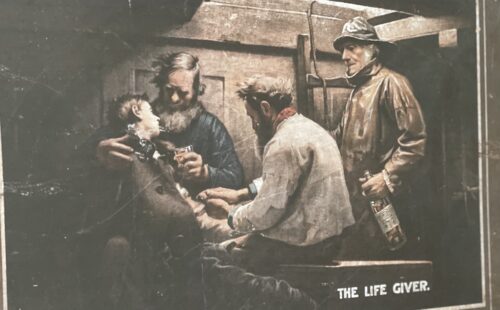
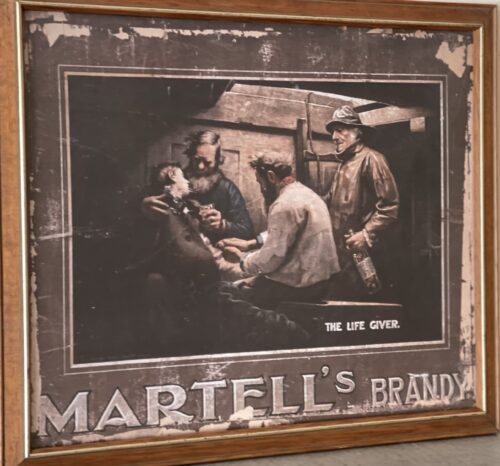 40cm x 34cm Limerick Martell is a Cognac house founded in 1715 by Jean Martell (1694–1753). It is part of the Martell Mumm Perrier-Jouët subsidiary of the French wines and spirits conglomerate Pernod Ricard. In 1715, Jean Martell, a young merchant originally from Jersey, created his own trading business at Gatebourse in Cognac, on the banks of the Charente, and thus founded one of the first cognac houses. Martell used grapes from the vineyards in the Borderie subregion, and used Tronçais oak for its casks, this made a combination that resulted in an exceptionally smooth cognac.After his death in 1753, his widow and then his two sons and grandson continued this tradition and developed the export business to make Martell the number one in England in 1814. In 1831, Martell created his first "VSOP" (Very Superior Old Pale) cognac and continued its international expansion. Its fame spread throughout the world, with the first exports to Japan and other Asian markets, such as Indonesia, Vietnam, Malaysia and Korea. On the coat of arms are what appear to be three small martels or war hammers, but could also be keg mallets. Cordon Bleu, created in 1912, is certainly the company’s most famous product. Martell was served aboard the Queen Mary in 1936 and even on Concorde in 1977. In 1987, Seagram took control of the French manufacturer for $1.2 billion. Since the acquisition of some of the Seagram Group’s spirits in 2001, Martell has belonged to the French spirits group, Pernod Ricard. In the 2000s, Martell created new cognacs: "Martell XO" in 2005, "Martell Création Grand Extra" in 2007, in a bottle designed by the artist and glass designer Serge Mansau. In 2009, Martell cognac launched its signature cognac, "L'Or de Jean Martell". In 2011, Martell expanded its "ultra-prestige" range with an exceptional cognac, "Martell Chanteloup Perspective", a tribute to the know-how of the cellar masters and to the Domaine de Chanteloup. In 2006, Martell joined the Comité Colbert, an association that promotes French luxury houses on an international scale. In 2010, Martell renewed its sponsorship with the Palace of Versailles, which began in 2007, by supporting the restoration of the Queen’s antechamber. In 2012, Martell Cordon Bleu, which was launched by Edouard Martell in 1912 at the Hotel de Paris in Monaco, celebrated its 100th birthday in the same place.
40cm x 34cm Limerick Martell is a Cognac house founded in 1715 by Jean Martell (1694–1753). It is part of the Martell Mumm Perrier-Jouët subsidiary of the French wines and spirits conglomerate Pernod Ricard. In 1715, Jean Martell, a young merchant originally from Jersey, created his own trading business at Gatebourse in Cognac, on the banks of the Charente, and thus founded one of the first cognac houses. Martell used grapes from the vineyards in the Borderie subregion, and used Tronçais oak for its casks, this made a combination that resulted in an exceptionally smooth cognac.After his death in 1753, his widow and then his two sons and grandson continued this tradition and developed the export business to make Martell the number one in England in 1814. In 1831, Martell created his first "VSOP" (Very Superior Old Pale) cognac and continued its international expansion. Its fame spread throughout the world, with the first exports to Japan and other Asian markets, such as Indonesia, Vietnam, Malaysia and Korea. On the coat of arms are what appear to be three small martels or war hammers, but could also be keg mallets. Cordon Bleu, created in 1912, is certainly the company’s most famous product. Martell was served aboard the Queen Mary in 1936 and even on Concorde in 1977. In 1987, Seagram took control of the French manufacturer for $1.2 billion. Since the acquisition of some of the Seagram Group’s spirits in 2001, Martell has belonged to the French spirits group, Pernod Ricard. In the 2000s, Martell created new cognacs: "Martell XO" in 2005, "Martell Création Grand Extra" in 2007, in a bottle designed by the artist and glass designer Serge Mansau. In 2009, Martell cognac launched its signature cognac, "L'Or de Jean Martell". In 2011, Martell expanded its "ultra-prestige" range with an exceptional cognac, "Martell Chanteloup Perspective", a tribute to the know-how of the cellar masters and to the Domaine de Chanteloup. In 2006, Martell joined the Comité Colbert, an association that promotes French luxury houses on an international scale. In 2010, Martell renewed its sponsorship with the Palace of Versailles, which began in 2007, by supporting the restoration of the Queen’s antechamber. In 2012, Martell Cordon Bleu, which was launched by Edouard Martell in 1912 at the Hotel de Paris in Monaco, celebrated its 100th birthday in the same place. -
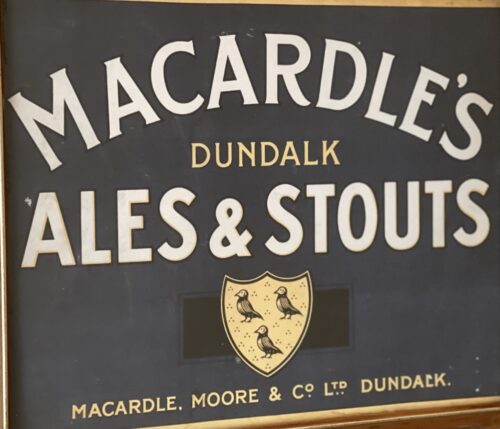
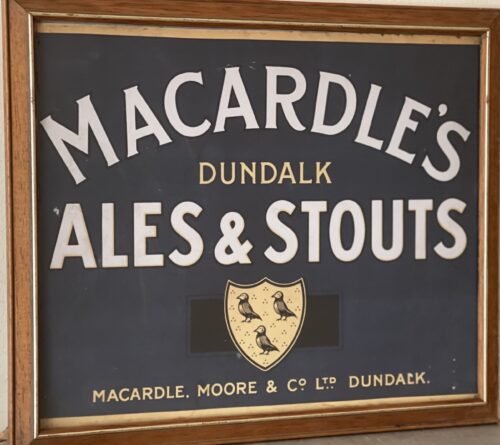 40cm x 34cm Limerick MacArdle Moore Brewery was a brewery in Dundalk, Ireland, formed in 1850 from the merger of two older breweries, McAllisters and Wynnes. Over the years it was to become almost synonymous with brewing in Dundalk. It joined the Guinness empire in the late 1960s. It gave its name to MacArdle's Traditional Ale, an Irish red ale, which is still produced by Diageo, at their St. James's Gate facility in Dublin. It was announced in 2000 that the brewery and a packing facility on the site were to be closed.Brewing resumed on the site by the beverages division of Alltech in 2018, with the move of their brewing from Newry
40cm x 34cm Limerick MacArdle Moore Brewery was a brewery in Dundalk, Ireland, formed in 1850 from the merger of two older breweries, McAllisters and Wynnes. Over the years it was to become almost synonymous with brewing in Dundalk. It joined the Guinness empire in the late 1960s. It gave its name to MacArdle's Traditional Ale, an Irish red ale, which is still produced by Diageo, at their St. James's Gate facility in Dublin. It was announced in 2000 that the brewery and a packing facility on the site were to be closed.Brewing resumed on the site by the beverages division of Alltech in 2018, with the move of their brewing from Newry -
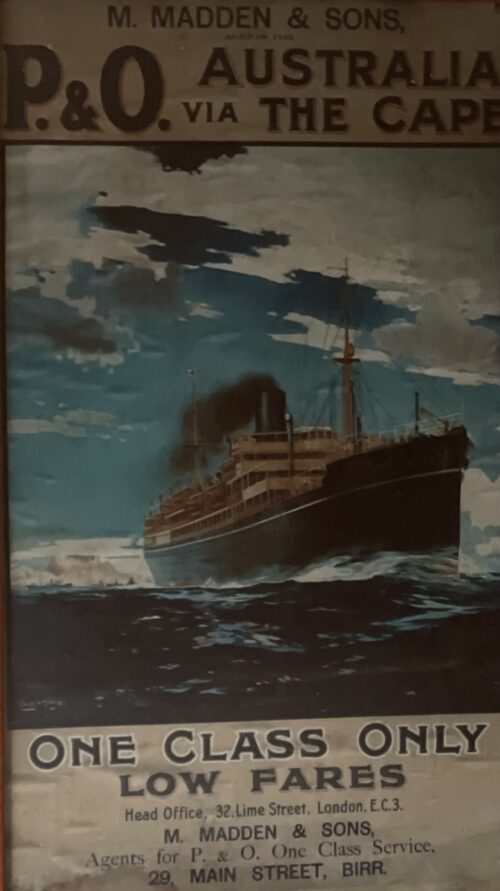
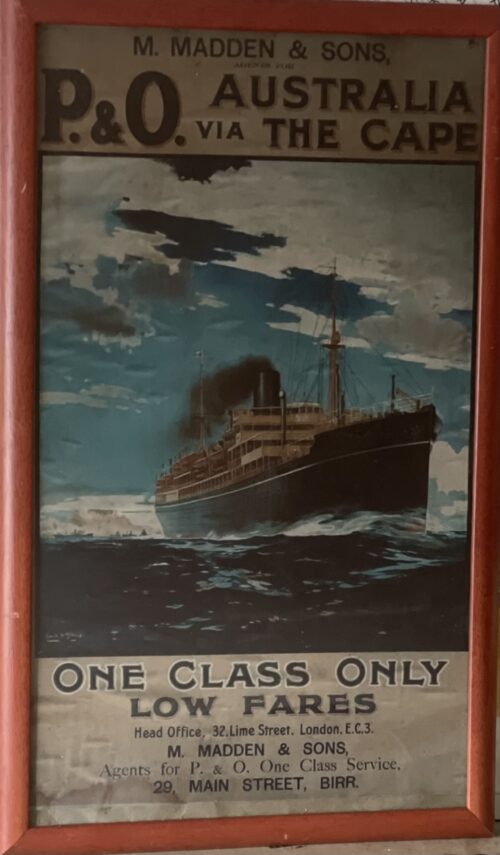 64cm x 39cm
64cm x 39cmEarly years and expansion: 1822–1900
In 1822, Brodie McGhie Willcox, a London ship broker, and Arthur Anderson, a sailor from the Shetland Isles, went into partnership to operate a shipping line, primarily operating routes between England and Spain and Portugal. In 1835, Dublin shipowner Captain Richard Bourne joined the business, and the three men chartered the William Fawcett and started a regular steamer service between London and Spain and Portugal – the Iberian Peninsula – using the name Peninsular Steam Navigation Company, with services to Vigo, Oporto, Lisbon and Cádiz. As The Peninsular and Oriental Steam Navigation Company was incorporated in 1840 by a royal charter its name therefore included neither "plc" nor "Limited". The company flag colours are directly connected with the Peninsular flags: the white and blue represent the Portuguese flag in 1837, and the yellow and red the Spanish flag. At the height of the Carlist Wars the British lent their support to the legitimate heirs of Spain and Portugal and all three of P&O founders played their part, from gun running to chartering steamers. As a consequence of this association and involvement P&O officers are some of the few Merchant Navy officers entitled to wear swords, alongside the likes of Trinity House. Admission ticket to Lord Mayor Thomas Gabriel's reception of H.I.M. The Sultan Abd-ul-Aziz Khan at The Guildhall, 18 July 1867, issued to The Chairman of the P&O Steam Navigation Company.
Admission ticket to Lord Mayor Thomas Gabriel's reception of H.I.M. The Sultan Abd-ul-Aziz Khan at The Guildhall, 18 July 1867, issued to The Chairman of the P&O Steam Navigation Company. William Fane De Salis(1812–1896), joined P&O in 1849. Director 1851–1895, Chairman 1878–1881.In 1837, the business won a contract from the British Admiralty to deliver mail to the Iberian Peninsula and in 1840 they acquired a contract to deliver mail to Alexandria in Egypt. Brindisi, Italy was added to the route in the 1870s. P&O first introduced passenger services in 1844, with a leisure cruise departing from Southampton to the Mediterranean.These voyages were the first of their kind and the forerunner of modern cruise holidays. The company later introduced round trips to destinations such as Alexandria and Constantinople and underwent rapid expansion in the later half of the 19th century, with its ships becoming larger and more luxurious. One particularly notable ship of the era was the SS Ravenna, built in 1880, which became the first ship to be built with a total steel superstructure. In 1847, shortly after the Opium War, P&O entered the opium trade; shipping 642,000 chests of Bengal and Malwa opium in the next eleven years. They faced stiff competition from the incumbent shippers, Jardines and the Apcar Line.
William Fane De Salis(1812–1896), joined P&O in 1849. Director 1851–1895, Chairman 1878–1881.In 1837, the business won a contract from the British Admiralty to deliver mail to the Iberian Peninsula and in 1840 they acquired a contract to deliver mail to Alexandria in Egypt. Brindisi, Italy was added to the route in the 1870s. P&O first introduced passenger services in 1844, with a leisure cruise departing from Southampton to the Mediterranean.These voyages were the first of their kind and the forerunner of modern cruise holidays. The company later introduced round trips to destinations such as Alexandria and Constantinople and underwent rapid expansion in the later half of the 19th century, with its ships becoming larger and more luxurious. One particularly notable ship of the era was the SS Ravenna, built in 1880, which became the first ship to be built with a total steel superstructure. In 1847, shortly after the Opium War, P&O entered the opium trade; shipping 642,000 chests of Bengal and Malwa opium in the next eleven years. They faced stiff competition from the incumbent shippers, Jardines and the Apcar Line.Early 20th century years: 1900–1945
Mail contracts were the basis of P&O's prosperity until the Second World War, but the company also continued to become a major commercial shipping line and passenger liner operator. In 1914, it took over the British India Steam Navigation Company, which was then the largest British shipping line, owning 131 steamers. In 1918, it gained a controlling interest in the Orient Line, its partner in the England-Australia mail route. Further acquisitions followed and the fleet reached a peak of almost 500 ships in the mid-1920s. In 1920, the company also established a bank, P&O Bank, that it sold to Chartered Bank of India, Australia and China (now Standard Chartered Bank) in 1927. At this time it established a commercial relationship with Spinney's of Haifa, that developed into a major regional high-end grocery store chain, which eventually provided shipping services access to much of the Middle East. Until 1934 it operated liners from Key West, Florida to Havana; then it operated from Miamito Cuba until 1960. In 1932, P&O expanded their passenger operations to Australia, with the introduction of Strathaird, which departed on a cruise to Brisbane and Norfolk Island. Eighty-five of the company's ships were sunk in the First World War and 179 in the Second World War.Post war: 1945–2000
After 1945, the passenger market declined to India, but boomed to Australia with the advent of paid-passages for literate and healthy European immigrants known as Ten Pound Poms.P&O built 15 large passenger liners, including Himalaya, Chusan, Arcadia, and Iberia, culminating in Oriana and Canberra, which were an unprecedented speed and size.By 1968, over 1 million immigrants had arrived—many via P&O—and Australia ended the programme. P&O entered the cruise market and began to sell and scrap many of these liners. It concentrated mainly on cargo ships. It entered the tanker trade in 1959 and the roll-on roll-off (RORO) ferry business in the mid-1960s. P&O and Orient Line were formally merged in 1960 to form P&O-Orient Lines. In 1964, Orcades and Oronsay were transferred to the P&O fleet. The name Orient Line was dropped altogether in 1966 when Orsova and Oriana were also transferred to the P&O fleet. -

 47cm x 37cm Limerick Here’s a quick, but loaded, question: Do you prefer Barry’s or Lyons? The Great Irish Tea War is the most intractable rivalry in the country. While Munster and Leinster have been known to put their differences aside for the sake of Irish rugby glory, tea drinkers are not so easily appeased. Mention a preference for the “wrong” tea and you can expect strong words at best – and definitely no biscuits. At worst, tea drinkers will go cup to cup in pitched battles, kettles angrily steaming, while insults like curdled milk sour friendships and family relationships. It’s more than just a battle of the brews. Barry’s Tea was founded the Rebel City in 1901 and is still one of Cork’s most famous brands. Lyons is originally from Dublin. Do you prefer Barry’s to Lyons? The yellow Snack or the purple one? Tayto or King Crisps? Cork or Dublin? Really, it is all a matter of taste… But there are many great reasons why anyone looking for a new job, or a whole new life, should consider a move to Cork.Lyons is a brand of tea belonging to Unilever that is sold in Ireland. It is one of the two dominant tea brands in the market within the Republic of Ireland, along with Barry's Tea. Lyons Tea was first produced by J. Lyons and Co., a catering empire created and built by the Salmons and Glucksteins, a German-Jewish immigrant family based in London. Starting in 1904, J Lyons began selling packaged tea through its network of teashops. Soon after, they began selling their own brand Lyons Tea through retailers in the UK, Ireland and around the world.In 1918, Lyons purchased Hornimans and in 1921 they moved their tea factory to J. Lyons and Co., Greenford at that time, the largest tea factory in Europe. In 1962, J Lyons and Company (Ireland) became Lyons Irish Holdings. After a merger with Allied Breweries in 1978, Lyons Irish Holdings became part of Allied Lyons (later Allied Domecq) who then sold the company to Unilever in 1996. Today, Lyons Tea is produced in England. Lyons Tea was a major advertiser in the early decades of RTÉ Television, featuring the "Lyons minstrels" and coupon-based prize competitions. The story of J Lyons is told in the book 'Legacy: One Family, a Cup of Tea and the Company that Took On the World' by Thomas Harding (writer)
47cm x 37cm Limerick Here’s a quick, but loaded, question: Do you prefer Barry’s or Lyons? The Great Irish Tea War is the most intractable rivalry in the country. While Munster and Leinster have been known to put their differences aside for the sake of Irish rugby glory, tea drinkers are not so easily appeased. Mention a preference for the “wrong” tea and you can expect strong words at best – and definitely no biscuits. At worst, tea drinkers will go cup to cup in pitched battles, kettles angrily steaming, while insults like curdled milk sour friendships and family relationships. It’s more than just a battle of the brews. Barry’s Tea was founded the Rebel City in 1901 and is still one of Cork’s most famous brands. Lyons is originally from Dublin. Do you prefer Barry’s to Lyons? The yellow Snack or the purple one? Tayto or King Crisps? Cork or Dublin? Really, it is all a matter of taste… But there are many great reasons why anyone looking for a new job, or a whole new life, should consider a move to Cork.Lyons is a brand of tea belonging to Unilever that is sold in Ireland. It is one of the two dominant tea brands in the market within the Republic of Ireland, along with Barry's Tea. Lyons Tea was first produced by J. Lyons and Co., a catering empire created and built by the Salmons and Glucksteins, a German-Jewish immigrant family based in London. Starting in 1904, J Lyons began selling packaged tea through its network of teashops. Soon after, they began selling their own brand Lyons Tea through retailers in the UK, Ireland and around the world.In 1918, Lyons purchased Hornimans and in 1921 they moved their tea factory to J. Lyons and Co., Greenford at that time, the largest tea factory in Europe. In 1962, J Lyons and Company (Ireland) became Lyons Irish Holdings. After a merger with Allied Breweries in 1978, Lyons Irish Holdings became part of Allied Lyons (later Allied Domecq) who then sold the company to Unilever in 1996. Today, Lyons Tea is produced in England. Lyons Tea was a major advertiser in the early decades of RTÉ Television, featuring the "Lyons minstrels" and coupon-based prize competitions. The story of J Lyons is told in the book 'Legacy: One Family, a Cup of Tea and the Company that Took On the World' by Thomas Harding (writer)Popular culture
A Lyons Tea sign is shown in the background in a scene in Castletown in The Quiet Man (1952), the iconic film directed by John Ford that starred John Wayne and Maureen O'Hara. Again in Ford’s ‘’How Green Was My Valley’’ (1941) an advertisement for Lyon’s Tea is to be seen in an early scene under the shop window near the church. In the BBC/RTÉ Mrs Brown's Boys TV series, there is a box of Lyons Tea sitting on top of the bread bin in Mrs Brown's kitchen. In Chariots of Fire, a Lyons sign is shown at Dover train station.




